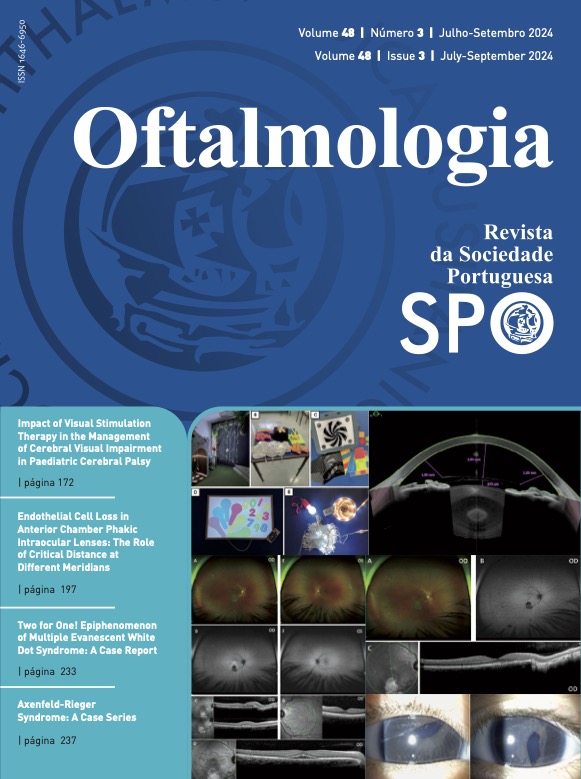Procura da Perfeição nos Olhos Mais Curtos: Cálculo da Potência da Lente Intraocular em Olhos com Comprimento Axial Inferior a 21 mm
DOI:
https://doi.org/10.48560/rspo.33203Palavras-chave:
Comprimento Axial do Olho, Implante de Lente Intraocular, Lentes Intraoculares, Olho/anatomia e histologiaResumo
INTRODUÇÃO: A cirurgia de catarata evoluiu na procura da perfeição. Contudo, a eficácia no cálculo da lente intraocular (LIO) é inferior nos olhos curtos. Assim, este estudo pretendeu comparar 11 fórmulas de cálculo de LIO nos outcomes refrativos após cirurgia de catarata em olhos com comprimento axial (CA) inferior a 21,0 mm.MÉTODOS: Análise retrospetiva de doentes submetidos a facoemulsificação de catarata sem complicações num hospital terciário entre Janeiro 2020 e Junho 2023. O erro de predição (EP) foi calculado como a diferença entre o equivalente esférico (ES) da refração subjetiva e o ES alvo para cada fórmula. O erro absoluto (EA) foi o valor absoluto do EP. Para cada fórmula e LIO, o EP foi zerado subtraindo o EP médio de cada fórmula. Foram definidos 2 grupos de acordo com a potência da LIO: grupo 1 (potência inferior a 30,0 D) e grupo 2 (potência superior a 30,0 D). O total de LIOs esféricas e os 2 subgrupos foram analisados separadamente.
RESULTADOS: Foram incluídos 87 olhos de 55 pacientes, com um CA de 20,48 ± 0,55 (intervalo 18,06-21,00) mm. O grupo 2 incluiu Acrysof® SN60AT IOLs e o grupo 1 incluiu Clareon® CNA0T0. O EP não zerado foi menor para a fórmula Pearl DGS no grupo 2 (-0,03 ± 0,66 D) e Kane no grupo 1 (0,05 ± 0,55 D). Após zerar o EP, a Pearl DGS foi a mais fiável (EA médio (EAM) 0,40 D) em todas as LIOs, enquanto Kane demonstrou menor erro no grupo 1. EAM foi significativamente superior nas fórmulas Haigis (p=0,045) e Barrett Universal II (p=0,036) no grupo 2. Apesar da Hill-RBF demonstrar bons resultados no grupo 1, demonstrou resultados insuficientes no grupo 2 (EAM 0,37 vs EAM 0,56 D, respetivamente).
CONCLUSÃO: A fórmula Pearl DGS demonstrou menor erro no grupo 2, enquanto a fórmula Kane demonstrou excelentes resultados no grupo 1. Hill-RBF demonstrou bons resultados para LIOs inferiores a 30,0 D. Haigis e Barrett Universal II demonstraram resultados desapontantes. A aplicação de métodos modernos e fórmulas para o cálculo da LIO irá promover resultados ainda mais exatos.
Downloads
Referências
Pascolini D, Mariotti SP. Global estimates of visual impairment: 2010. Br J Ophthalmol. 2012;96:614-8. doi:10.1136/bjophthalmol-2011-300539
Wang W, Yan W, Fotis K, Prasad NM, Lansingh VC, Taylor HR, et al. Cataract Surgical Rate and Socioeconomics: A Global Study. Invest Ophthalmol Vis Sci. 2017;57:5872. doi:10.1167/iovs.16-19894
Gollogly HE, Hodge DO, St Sauver JL, Erie JC. Increasing incidence of cataract surgery: population-based study. J Cataract Refract Surg. 2013;39:1383-9. doi:10.1016/j.jcrs.2013.03.027
Melles RB, Holladay JT, Chang WJ. Accuracy of Intraocular Lens Calculation Formulas. Ophthalmology. 2018;125:169-78. doi:10.1016/j.ophtha.2017.08.027
Connell BJ, Kane JX. Comparison of the Kane formula with existing formulas for intraocular lens power selection. BMJ Open Ophthalmol. 2019;4:e000251. doi:10.1136/bmjophth-2018-000251
Aristodemou P, Knox Cartwright NE, Sparrow JM, Johnston RL. Intraocular lens formula constant optimization and partial coherence interferometry biometry: Refractive outcomes in 8108 eyes after cataract surgery. J Cataract Refract Surg. 2011;37:50-62. doi:10.1016/j.jcrs.2010.07.037
Olsen T, Thim K, Corydon L. Accuracy of the newer generation intraocular lens power calculation formulas in long and short eyes. J Cataract Refract Surg. 1991;17:187-93. doi:10.1016/s0886-3350(13)80249-0
Holladay JT, Gills JP, Leidlein J, Cherchio M. Achieving emmetropia in extremely short eyes with two piggyback posterior chamber intraocular lenses. Ophthalmology. 1996;103:1118-23. doi:10.1016/s0161-6420(96)30558-7
Wang JK, Chang SW. Optical biometry intraocular lens power calculation using different formulas in patients with different axial lengths. Int J Ophthalmol. 2013;6:150-4. doi:10.3980/j.issn.2222-3959.2013.02.08
Kane JX, Melles RB. Intraocular lens formula comparison in axial hyperopia with a high-power intraocular lens of 30 or more diopters. J Cataract Refract Surg. 2020;46:1236-9. doi:10.1097/j.jcrs.0000000000000235
Wang L, Cao D, Weikert MP, Koch DD. Calculation of Axial Length Using a Single Group Refractive Index versus Using Different Refractive Indices for Each Ocular Segment: Theoretical Study and Refractive Outcomes. Ophthalmology. 2019;126:663-70. doi:10.1016/j.ophtha.2018.12.046
Olsen T. Calculation of intraocular lens power: a review. Acta Ophthalmologica Scandinavica. 2007;85:472-85. doi:10.1111/j.1600-0420.2007.00879.x
Wendelstein J, Hoffmann P, Hirnschall N, Fischinger IR, Mariacher S, Wingert T, et al. Project hyperopic power prediction: accuracy of 13 different concepts for intraocular lens calculation in short eyes. Br J Ophthalmol. 2022;106:795-801. doi:10.1136/bjophthalmol-2020-318272
Retzlaff JA, Sanders DR, Kraff MC. Development of the SRK/T intraocular lens implant power calculation formula. J Cataract Refract Surg. 1990;16:333-40. doi:10.1016/s0886-3350(13)80705-5
Hoffer KJ. The Hoffer Q formula: a comparison of theoretic and regression formulas. J Cataract Refract Surg. 1993;19:700-12. doi:10.1016/s0886-3350(13)80338-0
Holladay JT, Prager TC, Chandler TY, Musgrove KH, Lewis JW, Ruiz RS. A three-part system for refining intraocular lens power calculations. J Cataract Refract Surg. 1988;14:17-24. doi:10.1016/s0886-3350(88)80059-2
Guo C, Yin S, Qiu K, Zhang M. Comparison of accuracy of intraocular lens power calculation for eyes with an axial length greater than 29.0 mm. Int Ophthalmol. 2022;42:2029-38. doi:10.1007/s10792-021-02194-1
Shammas HJ, Taroni L, Pellegrini M, Shammas MC, Jivrajka RV. Accuracy of newer intraocular lens power formulas in short and long eyes using sum-of-segments biometry. J Cataract Refract Surg. 2022;48:1113-20. doi:10.1097/j.jcrs.0000000000000958
Hoffer KJ, Aramberri J, Haigis W, Olsen T, Savini G, Sham-mas HJ, et al. Protocols for studies of intraocular lens formula accuracy. Am J Ophthalmol. 2015;160:403-5.e1. doi:10.1016/j.ajo.2015.05.029
Dervin E, Arfat MY. Comparison of Two Formulae (SRK-T and Hoffer Q) for Intraocular Lens (IOL) Power Calculation in Eyes with Short Axial Length (AL) <22mm. P J M H S. 2018;12: 1093-4.
Gökce SE, Zeiter JH, Weikert MP, Koch DD, Hill W, Wang L. Intraocular lens power calculations in short eyes using 7 formulas. J Cataract Refract Surg. 2017;43:892-7. doi:10.1016/j.jcrs.2017.07.004
MacLaren RE, Natkunarajah M, Riaz Y, Bourne RR, Restori M, Allan BD. Biometry and formula accuracy with intraocular lenses used for cataract surgery in extreme hyperopia. Am J Ophthalmol. 2007;143:920-31. doi:10.1016/j.ajo.2007.02.043
Roh YR, Lee SM, Han YK, Kim MK, Wee WR, Lee JH. Intraocular Lens Power Calculation Using IOLMaster and Various Formulas in Short Eyes. Korean J Ophthalmol. 2011;25:151-5. doi:10.3341/kjo.2011.25.3.151
Shrivastava AK, Behera P, Kumar B, Nanda S. Precision of intraocular lens power prediction in eyes shorter than 22 mm: An analysis of 6 formulas. J Cataract Refract Surg. 2018;44:1317-20. doi:10.1016/j.jcrs.2018.07.023
Voytsekhivskyy OV, Hoffer KJ, Savini G, Tutchenko LP, Hipólito-Fernandes D. Clinical Accuracy of 18 IOL Power Formulas in 241 Short Eyes. Curr Eye Res. 2021;46:1832-43. doi:10.1080/02713683.2021.1933056
Hipólito-Fernandes D, Elisa Luís M, Gil P, Maduro V, Feijão J, Yeo TK, et al. VRF-G, a New Intraocular Lens Power Calculation Formula: A 13-Formulas Comparison Study. Clin Ophthalmol. 2020;14:4395-402. doi:10.2147/OPTH.S290125
Hipólito-Fernandes D, Luís ME, Serras-Pereira R, Gil P, Maduro V, Feijão J, et al. Anterior chamber depth, lens thickness and intraocular lens calculation formula accuracy: nine formulas comparison. Br J Ophthalmol. 2022;106:349-55. doi:10.1136/bjophthalmol-2020-317822
Debellemanière G, Dubois M, Gauvin M, Wallerstein A, Brenner LF, Rampat R, et al. The PEARL-DGS Formula: The Development of an Open-source Machine Learning-based Thick IOL Calculation Formula. Am J Ophthalmol. 2021;232:58-69. doi:10.1016/j.ajo.2021.05.004
Savini G, Di Maita M, Hoffer KJ, Næser K, Schiano-Lomoriello D, et al. Comparison of 13 formulas for IOL power calculation with measurements from partial coherence interferometry. Br J Ophthalmol. 2021;105:484-9. doi:10.1136/bjophthalmol-2020-316193
Melles RB, Kane JX, Olsen T, Chang WJ. Update on Intraocular Lens Calculation Formulas. Ophthalmology. 2019;126:1334-15. doi:10.1016/j.ophtha.2019.04.011
Cooke DL, Cooke TL. Comparison of 9 intraocular lens power calculation formulas. J Cataract Refract Surg. 2016;42:1157-64. doi:10.1016/j.jcrs.2016.06.029
Aristodemou P, Knox Cartwright NE, Sparrow JM, Johnston RL. Formula choice: Hoffer Q, Holladay 1, or SRK/T and refractive outcomes in 8108 eyes after cataract surgery with biometry by partial coherence interferometry. J Cataract Refract Surg. 2011;37:63-71. doi:10.1016/j.jcrs.2010.07.032
Carifi G, Aiello F, Zygoura V, Kopsachilis N, Maurino V. Accuracy of the refractive prediction determined by multiple currently available intraocular lens power calculation formulas in small eyes. Am J Ophthalmol. 2015;159:577-83. doi:10.1016/j.ajo.2014.11.036
Kane JX, Van Heerden A, Atik A, Petsoglou C. Intraocular lens power formula accuracy: Comparison of 7 formulas. J Cataract Refract Surg. 2016;42:1490-500. doi:10.1016/j.jcrs.2016.07.021
Vilaltella M, Cid-Bertomeu P, Huerva V. Accuracy of 10 IOL power calculation formulas in 100 short eyes (≤ 22 mm). Int Ophthalmol. 2023;43:2613-22. doi:10.1007/s10792-023-02660-y
Haigis W, Lege B, Miller N, Schneider B. Comparison of immersion ultrasound biometry and partial coherence interferometry for intraocular lens calculation according to Haigis. Graefes Arch Clin Exp Ophthalmol. 2000;238:765-73. doi:10.1007/s004170000188
Eom Y, Kang SY, Song JS, Kim YY, Kim HM. Comparison of Hoffer Q and Haigis formulae for intraocular lens power calculation according to the anterior chamber depth in short eyes. Am J Ophthalmol. 2014;157:818-24.e2. doi:10.1016/j.ajo.2013.12.017
Barrett GD. An improved universal theoretical formula for intraocular lens power prediction. J Cataract Refract Surg. 1993;19:713-20. doi:10.1016/s0886-3350(13)80339-2
Taroni L, Hoffer KJ, Pellegrini M, Lupardi E, Savini G. Comparison of the new Hoffer QST with 4 modern accurate formulas. J Cataract Refract Surg. 2023;49:378-84. doi:10.1097/j.jcrs.0000000000001126
Darcy K, Gunn D, Tavassoli S, Sparrow J, Kane JX. Assessment of the accuracy of new and updated intraocular lens power calculation formulas in 10 930 eyes from the UK National Health Service. J Cataract Refract Surg. 2020;46:2-7. doi:10.1016/j.jcrs.2019.08.014
Downloads
Publicado
Como Citar
Edição
Secção
Licença
Direitos de Autor (c) 2024 Revista Sociedade Portuguesa de Oftalmologia

Este trabalho encontra-se publicado com a Creative Commons Atribuição-NãoComercial 4.0.
Não se esqueça de fazer o download do ficheiro da Declaração de Responsabilidade Autoral e Autorização para Publicação e de Conflito de Interesses
O artigo apenas poderá ser submetido com esse dois documentos.
Para obter o ficheiro da Declaração de Responsabilidade Autoral, clique aqui
Para obter o ficheiro de Conflito de Interesses, clique aqui





